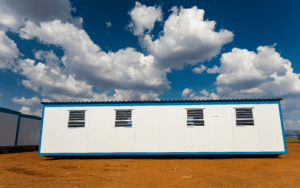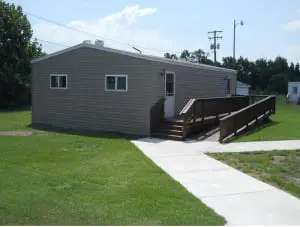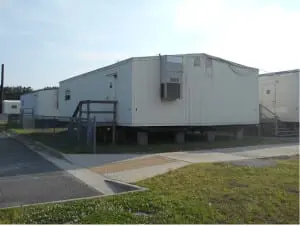
Portable Buildings vs. Traditional Construction: Pros and Cons
The construction industry has seen significant innovations over the years, with portable buildings becoming an increasingly popular alternative to traditional construction methods. These modular structures offer a range of benefits, but also come with their own set of challenges. This blog delves into the pros and cons of portable buildings compared to traditional construction, helping you make an informed decision for your next project.
Introduction to Portable Buildings
Portable buildings, also known as modular or prefabricated buildings, are constructed off-site in a controlled factory environment and then transported to the final location for assembly. These buildings can be used for various applications, including offices, schools, healthcare facilities, and residential homes. While the concept of portable buildings is not new, advancements in technology and construction techniques have made them more viable and attractive than ever before.
Introduction to Traditional Construction
Traditional construction involves building structures on-site from the ground up. This method has been the standard for centuries and includes a wide range of materials and techniques, from wood framing and brick masonry to steel and concrete construction. Traditional construction is known for its durability and flexibility, making it a popular choice for various types of buildings.

Pros of Portable Buildings
One of the most significant advantages of portable buildings is the speed of construction. Because the modules are built in a factory while site preparation occurs simultaneously, the overall construction time is significantly reduced. This efficiency allows for quicker project completion, which can be crucial for businesses and institutions needing rapid expansion or temporary facilities.
Cost-effectiveness is another major benefit of portable buildings. The assembly-line approach in factories lowers labor costs compared to on-site construction. Additionally, the precise manufacturing processes result in less material waste, reducing overall expenses. Fixed pricing models for portable buildings also help avoid unexpected costs that often arise in traditional construction.
- Reduced Labor Costs: The assembly-line approach in factories lowers labor costs compared to on-site construction.
- Less Material Waste: Precise manufacturing processes result in less material waste, reducing overall expenses.
- Predictable Costs: The fixed pricing models of portable buildings help avoid unexpected costs that often arise in traditional construction.
Flexibility and scalability are key strengths of portable buildings. Their modular design allows for easy expansion or reconfiguration as needs change. These buildings can also be disassembled and moved to a new location, providing a versatile solution for temporary needs. This relocatability makes them ideal for businesses that require flexible space solutions.
- Modular Design: The modular nature allows for easy expansion or reconfiguration as needs change.
- Relocatable: These buildings can be disassembled and moved to a new location, providing a versatile solution for temporary needs.
Sustainability is a growing concern in the construction industry, and portable buildings excel in this area. Many portable buildings are made from recycled or sustainable materials. The factory-controlled environment often results in better insulation and energy efficiency. Furthermore, on-site work is minimized, leading to less disruption to the environment and surrounding community.

Cons of Portable Buildings
Despite their many advantages, portable buildings do have some limitations. One of the primary drawbacks is design limitations. The modular design may limit architectural creativity and customization. Additionally, transportation regulations may impose size limits on modules, restricting the building’s dimensions.
- Aesthetic Constraints: The modular design may limit architectural creativity and customization.
- Size Restrictions: Transportation regulations may impose size limits on modules, restricting the building’s dimensions.
There can also be a negative perception associated with portable buildings. Some people perceive them as inferior or temporary compared to traditional structures. This stigma can affect their acceptance in certain markets. Additionally, portable buildings may have lower resale value and can be harder to finance or insure compared to traditional buildings.
Transporting the modules to the site can present challenges as well. The logistics of transporting large modules can be complex and costly, especially for remote locations. There is also a risk of damage during transportation, which can lead to additional costs and delays.
Pros of Traditional Construction
Traditional construction offers unmatched customization and flexibility. Architects and builders have complete freedom to create unique, tailored designs. This design freedom allows for a wide range of architectural styles and personalized features. Additionally, traditional construction methods allow for the use of various materials to achieve specific aesthetic and functional goals.
Durability and longevity are significant advantages of traditional construction. Structures built using traditional methods are known for their robust construction and long-lasting quality. The use of high-quality materials and techniques results in buildings that can withstand the test of time. Traditional construction methods have a proven track record of reliability, providing peace of mind to property owners.
Traditional buildings are often perceived as more valuable than portable buildings. They typically have higher resale values and are easier to finance and insure. The prestige associated with traditionally built structures enhances their appeal, making them a preferred choice for many property owners and developers.

Cons of Traditional Construction
One of the primary disadvantages of traditional construction is the time-consuming nature of the process. Projects can take months or even years to complete, depending on their complexity. Construction timelines can be extended due to delays caused by adverse weather conditions, leading to longer project durations and increased costs.
Traditional construction often comes with higher costs. The need for skilled labor on-site increases labor expenses significantly. On-site construction can also result in higher material waste and inefficiencies. Additionally, unforeseen issues such as site conditions or changes in design can lead to cost overruns and unexpected expenses.
Traditional construction can have a greater environmental impact compared to portable buildings. On-site construction can disrupt the local environment and ecosystem. The use of non-renewable resources and higher energy consumption during the construction process contribute to a larger carbon footprint.
Choosing the Right Option for Your Project
Deciding between portable buildings and traditional construction depends on several factors, including budget, timeline, location, and specific needs. For those with a limited budget and the need for a quick solution, portable buildings are likely the better option. They offer significant cost savings and predictable pricing, making them an attractive choice for many projects. If budget is less of a concern and you’re looking for a long-term investment, traditional construction might be more suitable. It provides opportunities for customization and potentially higher resale value. Traditional construction is best for projects where time is not a critical factor, allowing for meticulous planning and execution.

Budget Considerations
- Portable Buildings: If you have a limited budget and need a quick solution, portable buildings are likely the better option. They offer significant cost savings and predictable pricing.
- Traditional Construction: If budget is less of a concern and you’re looking for a long-term investment, traditional construction might be more suitable. It provides opportunities for customization and potentially higher resale value.
Project Timeline
- Portable Buildings: Ideal for projects with tight deadlines. The efficiency of off-site construction allows for rapid deployment.
- Traditional Construction: Best for projects where time is not a critical factor. The extended timelines allow for meticulous planning and execution.
Location and Site Conditions
- Portable Buildings: Suitable for sites with difficult access or where site preparation is challenging. The minimal on-site work required is a significant advantage.
- Traditional Construction: More appropriate for sites where there are no significant access issues, and the environmental impact can be managed.
Long-Term vs. Short-Term Needs
- Portable Buildings: Perfect for temporary or semi-permanent needs, such as construction site offices, temporary classrooms, or disaster relief housing.
- Traditional Construction: Better for permanent structures where long-term durability and architectural aesthetics are priorities.
Your long-term versus short-term needs should also be considered. Portable buildings are perfect for temporary or semi-permanent needs, such as construction site offices, temporary classrooms, or disaster relief housing. Traditional construction is better for permanent structures where long-term durability and architectural aesthetics are priorities.
Both portable buildings and traditional construction have their unique advantages and drawbacks. Portable buildings excel in cost-effectiveness, speed, flexibility, and sustainability, making them an excellent choice for many modern applications. However, they do come with design limitations and potential perception issues. Traditional construction offers unparalleled customization, durability, and perceived value, making it the preferred option for permanent and high-value projects. The trade-offs include higher costs, longer construction times, and a larger environmental impact.
Ultimately, the choice between portable buildings and traditional construction depends on your specific needs, budget, timeline, and project goals. By carefully considering these factors, you can make an informed decision that best suits your project requirements and ensures a successful outcome. Whether you opt for the speed and flexibility of portable buildings or the durability and customization of traditional construction, both methods offer viable solutions for different types of projects.

Leave a Reply